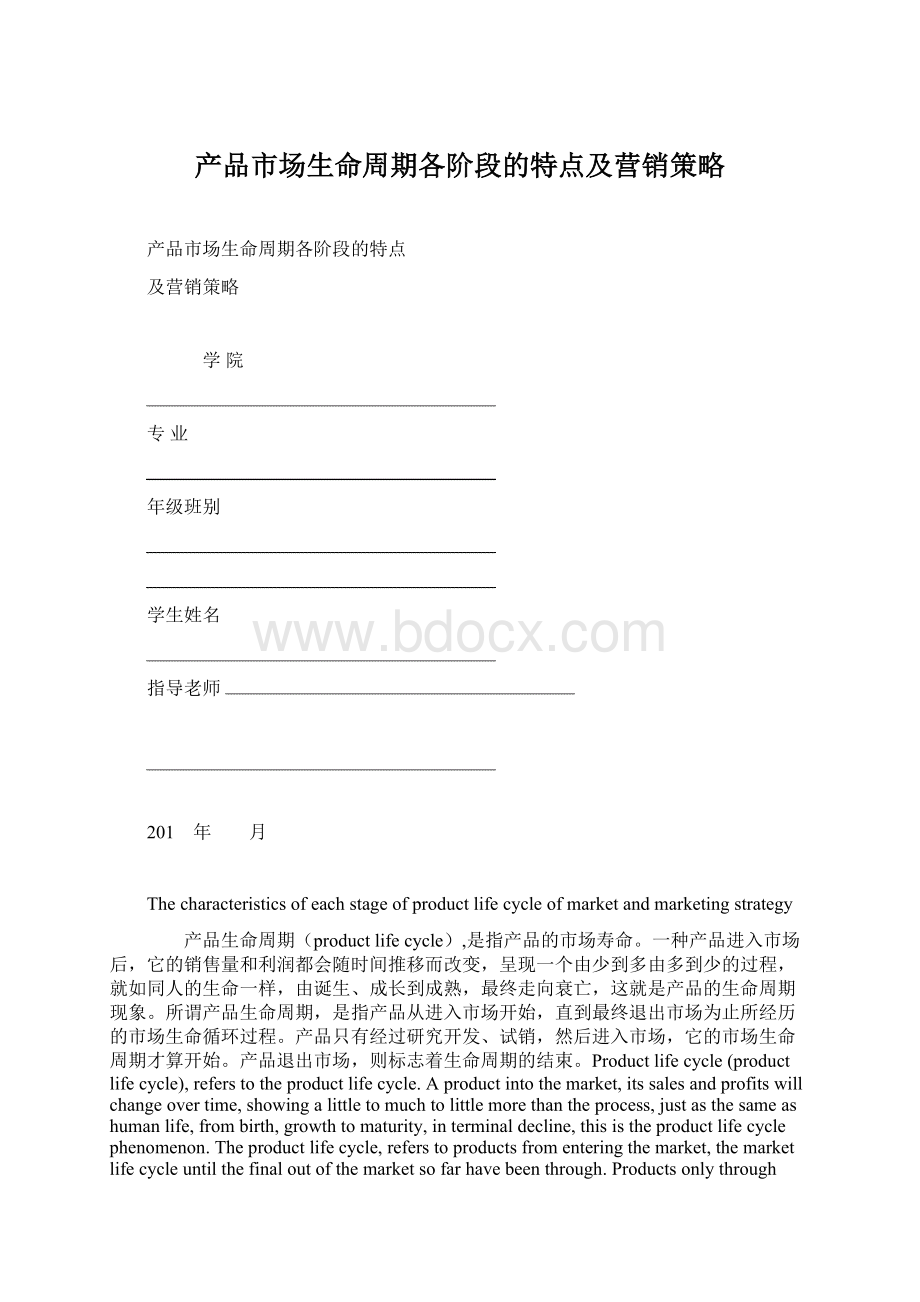产品市场生命周期各阶段的特点及营销策略.docx
《产品市场生命周期各阶段的特点及营销策略.docx》由会员分享,可在线阅读,更多相关《产品市场生命周期各阶段的特点及营销策略.docx(9页珍藏版)》请在冰豆网上搜索。

产品市场生命周期各阶段的特点及营销策略
产品市场生命周期各阶段的特点
及营销策略
学院
专业
年级班别
学生姓名
指导老师
201 年 月
Thecharacteristicsofeachstageofproductlifecycleofmarketandmarketingstrategy
产品生命周期(productlifecycle),是指产品的市场寿命。
一种产品进入市场后,它的销售量和利润都会随时间推移而改变,呈现一个由少到多由多到少的过程,就如同人的生命一样,由诞生、成长到成熟,最终走向衰亡,这就是产品的生命周期现象。
所谓产品生命周期,是指产品从进入市场开始,直到最终退出市场为止所经历的市场生命循环过程。
产品只有经过研究开发、试销,然后进入市场,它的市场生命周期才算开始。
产品退出市场,则标志着生命周期的结束。
Productlifecycle(productlifecycle),referstotheproductlifecycle.Aproductintothemarket,itssalesandprofitswillchangeovertime,showingalittletomuchtolittlemorethantheprocess,justasthesameashumanlife,frombirth,growthtomaturity,interminaldecline,thisistheproductlifecyclephenomenon.Theproductlifecycle,referstoproductsfromenteringthemarket,themarketlifecycleuntilthefinaloutofthemarketsofarhavebeenthrough.Productsonlythroughresearchanddevelopment,test,andthenenteredthemarket,itsmarketlifecyclebegins.Productsfromthemarket,markstheendofthelifecycle.
产品生命周期分为导入期(Introduction)、成长期(Growth)、成熟期(Mature)、衰退期(Decline)四个阶段。
(一)导入期的特点及企业的营销策略
导入期是新产品进入市场的最初阶段。
其主要特点是:
(一)characteristicsandenterpriseintroductionstagemarketingstrategy
Introductionisthefirststageofthenewproductintothemarket.Itsmainfeaturesare:
1.生产成本高新产品刚开始生产时,数量不大,技术尚不稳定、不熟练,次品率也较高,因而制造成本较高。
2.促销费用大新产品刚投放市场时,其性能、质量、使用价值、特征等还未被人们认识,为迅速打开销路,提高知名度,需进行大量的广告宣传及其他促销活动,促销费用很大。
3.销售数量少因新产品还未赢得消费者的信赖,未被广泛接受,购买者较少。
4.竞争不激烈因新产品刚进入市场,销路不畅,企业无利甚至亏损,生产者较少,竞争尚未真正开始。
1).Theproductionofhighproductioncostofnewproductsatthebeginning,thenumberofsmall,technologyisnotstable,lessskilled,defectiverateishigher,sotheproductioncostishigh.
2).Costofsalesinnewproductonthemarket,itsperformance,quality,value,characteristicshavenotbeenrecognized,toquicklyopenthemarket,improvethevisibility,needtodoalotofadvertisingandotherpromotionalactivities,promotionalcostsmore.
3).Thenumberofsalesfornewproductshavefailedtowinthetrustofconsumers,arenotwidelyaccepted,buyersareless.
4).Noseriouscompetitionfornewproductsenteringthemarket,salesaresluggish,enterprisesnoprofitorevenlosses,lesscompetitiveproducers,hasnotreallystarted.
在导入期,企业主要的营销目标是迅速将新产品打入市场,在尽可能短的时间内扩大产品的销售量。
可采取的具体策略有:
Intheintroduction,themainmarketingtargetenterpriseisquicklytonewproductsintothemarket,expandproductsalesintheshortestpossibletime.Thespecificstrategiesaretobetakenwith:
1.积极开展卓有成效的广告宣传,采用特殊的促销方法,如示范表演、现场操作、实物展销、免费赠送、小包装试销等,广泛传播商品信息,帮助消费者了解商品,提高认知程度,解除疑虑。
2.积极攻克产品制造中尚未解决的某些技术问题,稳定质量。
并根据市场反馈,改进产品,提高质量。
3.就产品与价格的组合策略看,可运用不同策略。
1).Activeveryfruitfuladvertising,usingspecialpromotion,suchasdemonstration,on-siteoperation,realsale,freetrial,smallpackaging,widelyspreadthecommodityinformation,tohelpconsumersunderstandtheproducts,improvecognitiondegree,dispelmisgivings.
2).Positiveovercomesometechnicalproblemshavenotbeensolvedinproductmanufacturing,qualitystability.Andimprovetheproductsaccordingtothemarketfeedback,quality,improve.
3).Combinationstrategiesofproductandprice,canusedifferentstrategies.
(1)快速撇脂策略。
高价高促销策略,即企业以高价和大规模促销将新产品推进市场,加强市场渗透与扩张。
采用这一策略的条件是:
大部分潜在购买者根本不熟悉该产品,已经知道这种新产品的购买者求购心切,愿出高价;企业图7—11流行商品市场生命周期曲线图面临潜在竞争的威胁,急需以高价优质树立声誉,取得竞争优势。
(1)therapidskimmingstrategy.Highpromotionstrategy,istheenterprisewithhighandlarge-scalepromotionwillpromotenewproducts,market,strengthenthemarketpenetrationandexpansion.Usingthisstrategyis:
mostofthepotentialbuyersdonotknowtheproduct,knowthebuyersforthisnewproducttobuypants,offerprice;enterprisefigure7-11popularcommoditymarketlifecyclecurvefacepotentialcompetition,urgenttoestablishareputationofhighquality,competitiveadvantage.
(2)缓慢撇脂策略。
高价低促销策略,即企业以高价和低促销费用将新产品推进市场,以多获利润。
采用这一策略的条件是:
市场容量相对有限,消费对象相对稳定;大部分购买者对产品已有所了解,愿出高价购买;潜在竞争的威胁较小。
(2)slowskimmingstrategy.Lowpricepromotionstrategy,istheenterprisewithhighandlowcostofsaleswillpromotenewproductstomarket,profit.Usingthisstrategyis:
themarketcapacityisrelativelylimited,consumptionisrelativelystable;themajorityofbuyershavesomeknowledgeofproducts,iswillingtobuyhigh-pricedoutpotentialcompetitivethreatissmaller.
(3)快速渗透策略。
低价高促销策略,即企业以低价和大规模的促销活动将新产品推进市场,以最快的速度进行市场渗透和扩大市场占有率。
采用这一策略的市场条件是:
市场容量相当大,购买者对商品不了解而且对价格十分敏感;潜在竞争威胁大;商品的单位成本可因大批量生产而降低。
(3)therapidpenetrationstrategy.Thelowpriceandhighpromotionstrategy,istheenterprisetolow-costandlarge-scalepromotionalactivitieswillpromotenewproductsmarket,withthefastestspeedofmarketpenetrationandexpandmarketshare.Usingthisstrategythemarketconditionis:
themarketcapacityislarge,thepurchaserofgoodsdoesnotunderstandandverysensitivetotheprice;thepotentialthreatofcompetition;theunitcostofgoodscanbereducedduetomassproduction.
(4).缓慢渗透策略。
低价低促销策略,即企业以低价和少量的促销费用将新产品推进市场,以廉取胜,迅速占领市场。
采用这一策略的条件是:
市场容量大;购买者对产品较为熟悉,对价格较为敏感;有相当数量的潜在竞争者。
(4)theslowpenetrationstrategy.Lowsalespromotionstrategy,istheenterprisewithlowpriceandsmallamountofpromotionalcostswillpromotenewproductstowinmarket,low-cost,andquicklyoccupiedthemarket.Usingthisstrategyis:
themarketcapacity;buyersaremorefamiliarwiththeproduct,moresensitivetoprice;thereareanumberofpotentialcompetitors.
(二)成长期的特点及营销策略
成长期是产品在市场上已经打开销路,销售量稳步上升的阶段。
其主要特点有:
二)thecharacteristicsofgrowingandmarketingstrategy
Growthperiodisaproducthasopenedoutletsinthemarket,salessteadilyrisingstage.Itsmainfeaturesare:
1.购买者对商品已经比较熟悉,市场需求扩大,销售量迅速增加。
2.生产和销售成本大幅度下降,大批量生产和大批量销售使单位产品成本减少。
3.企业利润增加。
4.竞争者相继加入市场,竞争趋向激烈。
1).Buyersaremorefamiliarwiththecommodity,marketdemand,salesincreasedrapidly.
2).Productionandsalescostisgreatlyreduced,themassproductionandmassmarketingistoreducethecostofunitproduct.
3)corporateprofitsincrease.
4).Competitorshavejoinedthemarket,competitiontendstobefierce.
在成长期,企业的主要任务是进一步扩大产品的市场,提高市场占有率。
可采用的策略有Inthegrowthstage,themaintaskofenterprisesistofurtherexpandproductmarket,increasemarketshare.Thestrategy:
:
1.进一步提高产品质量,增加花色、品种、式样、规格,改进包装。
2.广告促销从介绍产品,提高知名度转到突出特色,建立形象,争创名牌。
3.开辟新的分销渠道,扩大商业网点。
4.在大量生产的基础上,适时降价或采用其他有效的定价策略,吸引更多购买者。
1).Tofurtherimproveproductquality,increasethevariety,color,style,size,toimprovepackaging.
2).Advertisingandpromotionfromtheintroductionofproducts,improvethevisibilitytohighlightthefeatures,imagebuilding,andstrivingforfamousbrand.
3).Opennewdistributionchannels,theexpansionofcommercialoutlets.
4).Onaproductionbasis,timelypriceorbyothereffectivepricingstrategies,attractmorebuyers.
(三)成熟期的特点及营销策略
成熟期是产品在市场上普及销售量达到高峰的饱和阶段。
其主要特点是:
(三)thecharacteristicsofmatureandmarketingstrategy
Matureperiodistheproductsalesmarketreachedsaturationinthepopularizationstagepeak.Itsmainfeaturesare:
1.产品已为绝大多数的消费者所认识与购买,销售量增长缓慢,处于相对稳定状态,并逐渐出现下降的趋势。
2.企业利润逐步下降。
3.竞争十分激烈。
1).Theproducthasthevastmajorityofconsumerawarenessandpurchase,salesgrowthslow,inarelativelystablestate,andgraduallydecline.
2)graduallydeclineincorporateprofits.
3).Thecompetitionisveryfierce.
在成熟期,企业的主要任务是牢固地占领市场,防止与抵抗竞争对手的蚕食进攻。
可采用的策略有:
1.从广度和深度上拓展市场,争取新顾客,刺激老顾客增加购买。
2.提高产品质量,进行产品多功能开发,创造新的产品特色,增加产品的使用价值。
3.改进营销组合策略,如调整价格、增加销售网点、开展多种促销活动、强化服务等。
Inthematurestage,themaintaskofenterprisesisfirmlyoccupiedthemarket,preventandresistnibbledcompetitors.Thestrategy:
1).Fromthebreadthanddepthofexpandingthemarket,strivefornewcustomers,oldcustomerstobuymorestimulus.
2).Toimprovethequalityofproducts,thedevelopmentofmultifunctionalproducts,createnewproducts,increasethevalueofaproduct.
3).Improvementofmarketingcombinationstrategy,suchastheadjustmentofprices,increasesalesoutlets,tocarryoutavarietyofpromotionalactivities,strengthentheserviceetc..
(四)衰退期的特点及营销策略
衰退期是产品销售量持续下降、即将退出市场的阶段。
其主要特点有:
1.消费者对产品已经没有兴趣,市场上出现了改进型产品,市场需求减少
2.同行业为减少存货损失,竞相降价销售,竞争激烈。
3.企业利润不断降低。
(四)therecessionofthecharacteristicandmarketingstrategy
Therecessionistheproductsalescontinuedtodecline,theoutgoingphase.Itsmainfeaturesare:
1).Consumershavenointerestinproducts,themarketappearedimprovedproducts,marketdemand
2).Withtheindustrytoreducetheinventoryloss,tolowersales,competitionisintense.
3)corporateprofitscontinuetoreduce.
在衰退期,企业的主要任务是尽快退出市场,尽量减少因存货过多给企业造成的亏损。
可选择的策略有:
1.淘汰策略,即企业停止生产衰退期产品,上马新产品或转产其他产品。
2.持续营销策略,即企业继续生产衰退期产品,利用其他竞争者退出市场的机会,通过提高服务质量、降低价格等方法维持销售。
Inarecession,themaintaskofenterprisesistowithdrawfromthemarketassoonaspossible,toreducethestockduetotoomuchenterpriselosses.Alternativestrategies:
1).Eliminationstrategy,enterprisesstopproductiondeclineperiod,launchednewproductsortransfertootherproducts.
2).Marketingstrategy,namelytheenterprisetocontinueproductiondeclineperiod,theuseofothercompetitorsoutofthemarketopportunities,byimprovingthequalityofservice,lowerpricesandothermethodstomaintainsales.
产品生命周期理论背景产品生命周期理论是美国哈佛大学教授费农1966年在其《产品周期中的国际投资与国际贸易》一文中首次提出的。
费农认为:
产品生命是指市上的营销生命,产品和人的生命一样,要经历形成、成长、成熟、衰退这样的周期,而这个周期在不同技术水平的国家里,发生的时间和过程是不一样的,其间存在一个较大的差距和时差,正是这一时差,表现为不同国家在技术上的差距,它反映场了同一产品在不同国家市场上的竞争地位的差异,从而决定了国际贸易和国际投资的变化,为了便于区分,费农把这些国家依次分成创新国(一般为最发达国家)、一般发达国家、发展中国家。
费农还把产品生命周期分为三个阶段,即新产品阶段,成熟产品阶段和标准化产品阶段。
费农认为,在新产品阶段,创新国利用其拥有的垄断技术优势,开发新产品,由于产品尚未完全成型,技术上未加完善,加之,竞争者少,市场竞争不激烈,替代产品少,产品附加值高,国内市场就能满足其摄取高额利润的要求等,产品极少出口到其他国家,绝大部分产品都在国内销售。
而在成熟产品阶段,由于创新国技术